

News
SpaceX stacks Starship and Super Heavy booster for “wet dress rehearsal” test
For the third time in three months, SpaceX has fully assembled Starship 24 and Super Heavy Booster 7 after another period of separate tests, repairs, and modifications.
Measuring around 120 meters (~390 ft) tall from ship tip to booster tail, the fully-stacked rocket is again the largest ever assembled. Compared to the Falcon 9 and Falcon Heavy rockets SpaceX currently operates, Starship is far larger. It’s also meant to be fully reusable, while the Falcon family – which expends its orbital upper stage – is roughly 80% reusable. If SpaceX can meet its technical goals, Starship could eventually cost around a magnitude less to launch than Falcon while carrying roughly 5-20 times more payload per launch. In short, it could revolutionize the cost of access to orbit.
Combined with orbital refilling, the ability to transfer propellant between Starships, reusable Starships could also radically exceed Falcon 9 or even Falcon Heavy’s expendable performance. But first, SpaceX needs to make sure that Starship can reach orbit at all.
Compared to Ship 20 and Booster 4, earlier prototypes that were also fully stacked a few times in 2021 and early 2022 before their retirement, Ship 24 and Booster 7 are closer to supporting Starship’s first orbital launch attempt. After their latest full-stack milestone, they could be just a few major tests away from being cleared for flight.
The update that's rolling out to the fleet makes full use of the front and rear steering travel to minimize turning circle. In this case a reduction of 1.6 feet just over the air— Wes (@wmorrill3) April 16, 2024
“According to CEO Elon Musk and a NASA official, the last major standalone test between Booster 7 and flight readiness is a full 33-engine static fire. Together, B7’s 33 Raptor 2 engines could produce up to 7600 tons (16.7 million lbf) of thrust at sea level, likely making Starship the most powerful rocket stage in the history of spaceflight.
A wet dress rehearsal is a routine test conducted before a rocket launch and is generally designed to simulate every aspect of a launch save for engine ignition and liftoff. Most importantly, that involves fully filling the rocket with propellant and passing all of the checks the same rocket would need to pass to be cleared for launch. The first full-stack WDR will test Starbase’s launch facilities just as much as Booster 7 and Ship 24.”
Teslarati.com – January 9th, 2023
The January 9th assembly of B7 and S24 confirms that the WDR will likely occur first, as conducting the first 33-Raptor Super Heavy static fire while fully stacked would unnecessarily risk the Starship. Ship 24 could fly on a future booster if B7 does not pass (or survive) proof testing. More likely than not, Ship 24 will be removed from Booster 7 after WDR testing, freeing Super Heavy for one last round of standalone static fire testing. If that testing clears Booster 7, Ship 24 will be reinstalled – possibly for the last time.
While hardware challenges continue to trump paperwork, an FAA launch license is another significant hurdle standing between SpaceX and Starship’s orbital launch debut. SpaceX and the FAA are in the middle of hammering out the details of such a license, which is partially contingent upon the completion of dozens of “mitigation” measures. Because Starship’s unprecedented size elevates the risk it could pose to local residents, it’s likely that that license is also contingent upon results from ground tests and will be one of the last gates to be lifted.
SpaceX has three windows that could be used for B7/S24 full-stack testing this week: two from 8am to 8pm CST on January 11th and 12th and one from 8am to 4pm on January 13th. CEO Elon Musk says that Starship could be ready for its first orbital launch attempt as early as late February or March 2023.

Elon Musk
Elon Musk confirms xAI’s purchase of five 380 MW natural gas turbines
The deal, which was confirmed by Musk on X, highlights xAI’s effort to aggressively scale its operations.

xAI, Elon Musk’s artificial intelligence startup, has purchased five additional 380 MW natural gas turbines from South Korea’s Doosan Enerbility to power its growing supercomputer clusters.
The deal, which was confirmed by Musk on X, highlights xAI’s effort to aggressively scale its operations.
xAI’s turbine deal details
News of xAI’s new turbines was shared on social media platform X, with user @SemiAnalysis_ stating that the turbines were produced by South Korea’s Doosan Enerbility. As noted in an Asian Business Daily report, Doosan Enerbility announced last October that it signed a contract to supply two 380 MW gas turbines for a major U.S. tech company. Doosan later noted in December that it secured an order for three more 380 MW gas turbines.
As per the X user, the gas turbines would power an additional 600,000+ GB200 NVL72 equivalent size cluster. This should make xAI’s facilities among the largest in the world. In a reply, Elon Musk confirmed that xAI did purchase the turbines. “True,” Musk wrote in a post on X.
xAI’s ambitions
Recent reports have indicated that xAI closed an upsized $20 billion Series E funding round, exceeding the initial $15 billion target to fuel rapid infrastructure scaling and AI product development. The funding, as per the AI startup, “will accelerate our world-leading infrastructure buildout, enable the rapid development and deployment of transformative AI products.”
The company also teased the rollout of its upcoming frontier AI model. “Looking ahead, Grok 5 is currently in training, and we are focused on launching innovative new consumer and enterprise products that harness the power of Grok, Colossus, and 𝕏 to transform how we live, work, and play,” xAI wrote in a post on its website.
Elon Musk
Elon Musk’s xAI closes upsized $20B Series E funding round
xAI announced the investment round in a post on its official website.

xAI has closed an upsized $20 billion Series E funding round, exceeding the initial $15 billion target to fuel rapid infrastructure scaling and AI product development.
xAI announced the investment round in a post on its official website.
A $20 billion Series E round
As noted by the artificial intelligence startup in its post, the Series E funding round attracted a diverse group of investors, including Valor Equity Partners, Stepstone Group, Fidelity Management & Research Company, Qatar Investment Authority, MGX, and Baron Capital Group, among others.
Strategic partners NVIDIA and Cisco Investments also continued support for building the world’s largest GPU clusters.
As xAI stated, “This financing will accelerate our world-leading infrastructure buildout, enable the rapid development and deployment of transformative AI products reaching billions of users, and fuel groundbreaking research advancing xAI’s core mission: Understanding the Universe.”
xAI’s core mission
Th Series E funding builds on xAI’s previous rounds, powering Grok advancements and massive compute expansions like the Memphis supercluster. The upsized demand reflects growing recognition of xAI’s potential in frontier AI.
xAI also highlighted several of its breakthroughs in 2025, from the buildout of Colossus I and II, which ended with over 1 million H100 GPU equivalents, and the rollout of the Grok 4 Series, Grok Voice, and Grok Imagine, among others. The company also confirmed that work is already underway to train the flagship large language model’s next iteration, Grok 5.
“Looking ahead, Grok 5 is currently in training, and we are focused on launching innovative new consumer and enterprise products that harness the power of Grok, Colossus, and 𝕏 to transform how we live, work, and play,” xAI wrote.
Investor's Corner
Tesla gets price target bump, citing growing lead in self-driving

Tesla (NASDAQ: TSLA) stock received a price target update from Pierre Ferragu of Wall Street firm New Street Research, citing the company’s growing lead in self-driving and autonomy.
On Tuesday, Ferragu bumped his price target from $520 to $600, stating that the consensus from the Consumer Electronics Show in Las Vegas was that Tesla’s lead in autonomy has been sustained, is growing, and sits at a multiple-year lead over its competitors.
CES 2026 validates Tesla’s FSD strategy, but there’s a big lag for rivals: analyst
“The signal from Vegas is loud and clear,” the analyst writes. “The industry isn’t catching up to Tesla; it is actively validating Tesla’s strategy…just with a 12-year lag.”
The note shows that the company’s prowess in vehicle autonomy is being solidified by lagging competitors that claim to have the best method. The only problem is that Tesla’s Vision-based approach, which it adopted back in 2022 with the Model 3 and Model Y initially, has been proven to be more effective than competitors’ approach, which utilizes other technology, such as LiDAR and sensors.
Currently, Tesla shares are sitting at around $433, as the company’s stock price closed at $432.96 on Tuesday afternoon.
Ferragu’s consensus on Tesla shares echoes that of other Wall Street analysts who are bullish on the company’s stock and position within the AI, autonomy, and robotics sector.
Dan Ives of Wedbush wrote in a note in mid-December that he anticipates Tesla having a massive 2026, and could reach a $3 trillion valuation this year, especially with the “AI chapter” taking hold of the narrative at the company.
Ives also said that the big step in the right direction for Tesla will be initiating production of the Cybercab, as well as expanding on the Robotaxi program through the next 12 months:
“…as full-scale volume production begins with the autonomous and robotics roadmap…The company has started to test the all-important Cybercab in Austin over the past few weeks, which is an incremental step towards launching in 2026 with important volume production of Cybercabs starting in April/May, which remains the golden goose in unlocking TSLA’s AI valuation.”
Tesla analyst breaks down delivery report: ‘A step in the right direction’
Tesla has transitioned from an automaker to a full-fledged AI company, and its Robotaxi and Cybercab programs, fueled by the Full Self-Driving suite, are leading the charge moving forward. In 2026, there are major goals the company has outlined. The first is removing Safety Drivers from vehicles in Austin, Texas, one of the areas where it operates a ride-hailing service within the U.S.
Ultimately, Tesla will aim to launch a Level 5 autonomy suite to the public in the coming years.








